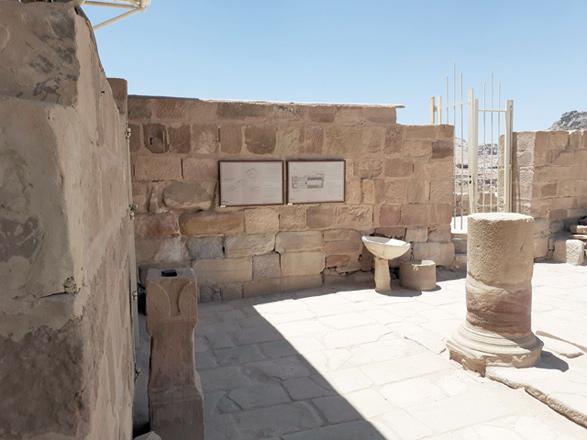You are here
Uncovering Petra’s ancient churches, shifting communities in Northern Ridge
By Saeb Rawashdeh - Nov 04,2023 - Last updated at Nov 04,2023

The Blue Chapel showing the reconstructed granite columns and Nabataean capital (Photo courtesy of Neil Bierling)
AMMAN — After excavation of the Petra Church, a group of researchers worked on two churches on the higher slope — the Ridge Church and the Blue Chapel. The Ridge Church is on the top of the hill while the Blue Chapel is immediately below. The Northern Ridge is an area of Petra where many tombs from Nabataean and Roman period were found (1st and 2nd century AD).
“The Northern Ridge has a handful of the Nabataean domestic complexes, two Roman period houses and a villa,” noted Sara Wenner, adding that two Aphrodite’s statues were recently found there in a dump pit.
Wenner’s work revolved around ceramics that were discovered at the Northern Ridge, additionally, she has been looking how domestic spaces were built and when they were used and why.
“My dissertation research was partially how these Nabataean and Roman period structures recycled Nabataean refuse in their floor and how they recycle material that would be a potential hindrance,” Wenner said.
Like many ancient peoples, Nabataean recycles different waste into their floor.
Regarding the Ridge area, in the 4th and 5th centuries the area became very important for the Christian community in Petra, noted Wenner, adding that the Petra Church, the Blue Chapel (made of a beautiful granite) and the Ridge Church were constructed at approximately the same time.
“The Christian community used to borrow architectural solutions from pagan temples,” Wenner said.
The earthquake that struck Levant in 363 AD had a devastating impact on Petra and its temples and it ended the use of the North Ridge as a place for people to live.
On the other hand, Jabal Harun had a monastery and the chapel on its top, Wenner continued, adding that the environment in Petra changed in 4th, 5th and 6th centuries compared to 1st and 2nd centuries.
“We have less evidence of people living in the rural area around Petra in late 2nd and early 3rd centuries, but during the Byzantine period there is evidence of re-occupation of the hinterland and the population moved eastward,” Wenner said.
Romans built a massive fortress around 400 AD and opportunities to trade and engage in with Roman legionaries who lived there drew lots of population towards east, Wenner claimed.
However, due to scarce evidence Wenner thinks that we need more excavations in the Northern Ridge to determine what was going on in the Byzantine and the Early Islamic periods.
Related Articles
AMMAN — The role of American Centre of Research (ACOR) in Amman in “salvaging the Jordanian cultural heritage” took centre stage during a re
AMMAN — The Petra Garden and Pool Complex (PGPC), which can be dated to the 1st century BC, had been a part of the monumental co
AMMAN — Between 1997 and 2013, the Finnish Jabal Haroun Project (FJHP) has carried out archaeological excavations at a Byzantine monastery l














